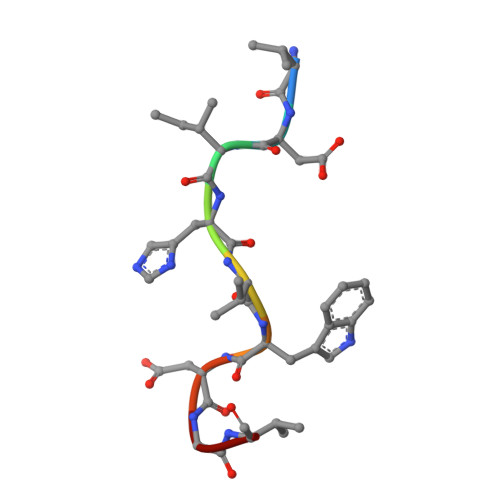Novel Peptide Inhibitors of Human Secretory Phospholipase A2 with Antiinflammatory Activity: Solution Structure and Molecular Modeling.
Thwin, M.M., Satyanarayanajois, S.D., Nagarajarao, L.M., Sato, K., Arjunan, P., Ramapatna, S.L., Kumar, P.V., Gopalakrishnakone, P.(2007) J Med Chem 50: 5938-5950
- PubMed: 17973469
- DOI: https://doi.org/10.1021/jm070385x
- Primary Citation of Related Structures:
2P5H, 2P5J - PubMed Abstract:
Secretory phospholipase A2 (sPLA2) and matrix metallopreoteinases (MMPs) are key enzymes involved in rheumatoid arthritis (RA), and their modulation thus represents a potential therapeutic option. On the basis of Escherichia coli radioassay, synthetic peptides were designed and screened for sPLA2 inhibition. The linear peptide, 10f (PIP-18), inhibited the recombinant human synovial sPLA2 activity with an IC50 of 1.19 microM. Not only did the peptide interfere with the function of sPLA2, but it also appeared to inhibit mRNA expression of sPLA2 and various MMPs in IL-1beta-stimulated RA synovial fibroblast (RASF) cultures and thereby the production of the corresponding proteins (>80% inhibition). Nuclear magnetic resonance (NMR), modeling, and docking studies indicate that in solution the peptide exhibits a beta-turn at residues Trp-Asp-Gly-Val and possibly binds to the hydrophobic channel of sPLA2. The results strongly suggest that the modulatory action of peptide 10f may play a major role in counteracting the development of RA.
Organizational Affiliation:
Department of Anatomy, Yong Loo Lin School of Medicine, 4 Medical Drive, National University of Singapore, Singapore 117597.














